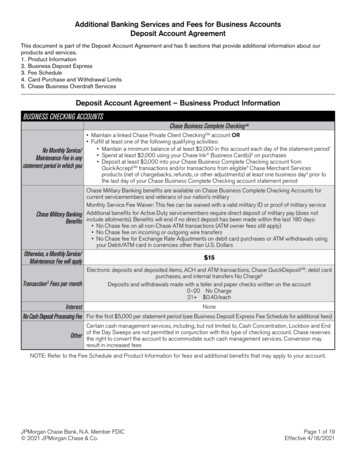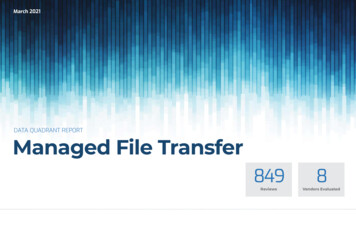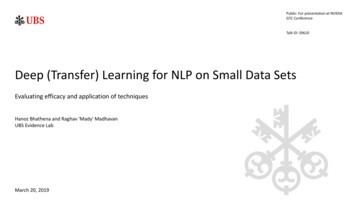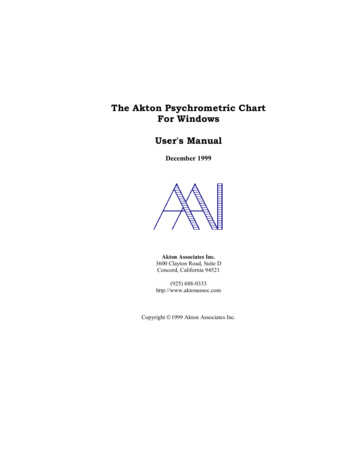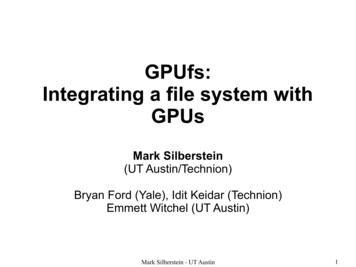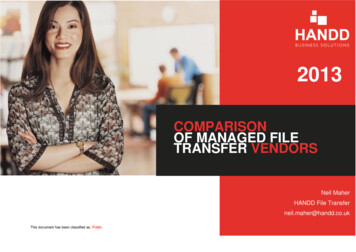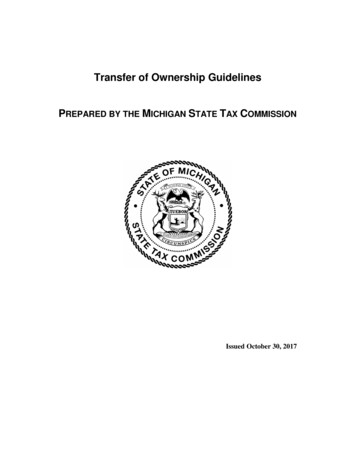
Transcription
Transfer of Ownership GuidelinesPREPARED BY THE MICHIGAN STATE TAX COMMISSIONIssued October 30, 2017
TABLE OF CONTENTSBackground Information3Transfer of Ownership Definitions4Deeds and Land Contracts4Trusts5Distributions Under Wills or By Courts8Leases10Ownership Changes of Legal Entities(Corporations, Partnerships, Limited Liability Companies, etc.)11Tenancies in Common12Cooperative Housing Corporations13Transfer of Ownership Exemptions13Spouses14Children and Other Relatives15Tenancies by the Entireties18Life Leases/Life Estates19Foreclosures and Forfeitures23Redemptions of Tax-Reverted Properties24Trusts25Court Orders26Joint Tenancies27Security Interests33Affiliated Groups34Normal Public Trades35Commonly Controlled Entities35Tax-Free Reorganizations37Qualified Agricultural Properties38Conservation Easements41Boy Scout, Girl Scout, Camp Fire Girls4-H Clubs or Foundations, YMCA and YWCA42Property Transfer Affidavits42Partial Uncapping Situations45Delayed Uncappings46
Background InformationWhy is a transfer of ownership significant with regard to property taxes?In accordance with the Michigan Constitution as amended by Michigan statutes, atransfer of ownership causes the taxable value of the transferred property to be uncappedin the calendar year following the year of the transfer of ownership.What is meant by “taxable value”?Taxable value is the value used to calculate the property taxes for a property. In general,the taxable value multiplied by the appropriate millage rate yields the property taxes for aproperty.What is meant by “taxable value uncapping”?Except for additions and losses to a property, annual increases in the property’s taxablevalue are limited to 1.05 or the inflation rate, whichever is less. In the year following astatutory transfer of ownership, that limitation is eliminated and the property’s taxablevalue is set at 50% of the property’s true cash value (i.e., the state equalized value).This is what is meant by “taxable value uncapping”. See Michigan Compiled Laws(MCL) 211.27a(3).Note: A property’s true cash value is usually not the same as its sale price for avariety of reasons. An assessor must determine the true cash value of a property whichhas sold in the same manner that the assessor determines the true cash values ofproperties which have not sold. Therefore, an assessor may not automatically set anassessed value or a taxable value at half of a property’s selling price. See State TaxCommission Bulletin No. 19 of 1997 and State Tax Commission Memorandum datedOctober 25, 2005 that describes the illegal and unconstitutional practice of “followingsales.”Can an assessor disregard a statutory transfer of ownership (i.e., can an assessordecide not to uncap a property’s taxable value in the year following a transfer ofownership)?No. By statute an assessor must uncap a property’s taxable value in the year followingthe transfer of ownership of that property. The assessor shall set the property’s taxablevalue for the calendar year following the year of the transfer of ownership as theproperty’s state equalized valuation for the calendar year following the transfer. See MCL211.27a(3).If two sections of MCL 211.27a(6) or (7) appear to be in conflict, how should thatconflict be resolved?MCL 211.27a(6) includes a non-exhaustive list of conveyances that will constitute a3
transfer of ownership, and MCL 211.27a(7) lists conveyances that do not constitute sucha transfer. When two statutory provisions conflict and one is specific while the other isonly generally applicable, the specific provision prevails.Transfer of Ownership DefinitionsWhat is a transfer of ownership?Central to the concept of transfer of ownership is a change in the beneficial use of theproperty. Michigan statute defines “transfer of ownership” generally as the conveyanceof title to or a present interest in property, including the beneficial use of the property,the value of which is substantially equal to the value of the fee interest. MCL 211.27a(6)(a)-(j) provides a variety of examples of what constitutes a transfer of ownership fortaxable value uncapping purposes. If a transfer of property (or ownership interest) meetsone of these definitions and does not fall under one of the exceptions or exemptionsnoted in the law, that transfer is a transfer of ownership. Transfer of ownershipdefinitions and transfer of ownership exceptions are contained in MCL 211.27a(6)(a)(j) (See appendix). Transfer of ownership exemptions are contained in MCL211.27a(7)(a)-(x). (See appendix)Deeds and Land ContractsIs a conveyance of a property by deed a transfer of ownership?A transfer of property by deed is a transfer of ownership. See MCL 211.27a(6)(a).Is a sale by land contract a transfer of ownership?A transfer of property by land contract is a transfer of ownership. See MCL 211.27a(6)(b).If a property is sold by land contract, when does the transfer of ownership occur?The transfer of ownership occurs on the date the land contract is entered into—not thedate the land contract is recorded, nor the date the land contract is completed (paid infull) and not the date a deed conveying title to the property is recorded in the office ofthe register of deeds in the county in which the property is located.Does a second transfer of ownership occur when a land contract is paid in full anda deed in fulfillment of the land contract is given?No. The law specifically states that a property’s taxable value is not to be uncapped whena deed conveying title to the property is subsequently recorded with the register of deeds.Is the assignment of a seller’s interest in a land contract a transfer of ownership?No, this is considered a transfer of a security interest and is exempt by law from being a4
transfer of ownership.Is the assignment of a buyer’s interest in a land contract a transfer of ownership?Yes, the assignment of a land contract buyer’s interest in a property conveys equitable titleto the property and a change in the beneficial use of the property occurs resulting ina transfer of ownership.TrustsIs a conveyance of property to a trust a transfer of ownership?Yes, pursuant to MCL 211.27a(6)(c), a conveyance to a trust after December 31,1994, is a transfer of ownership. However, if the grantor stated on the deed is thesettlor (creator) of the trust or the settlor’s spouse or both and the sole presentbeneficiary of the trust is the settlor of the trust or the settlor’s spouse or both, theconveyance is not a transfer of ownership. See MCL 211.27a(6)(c)(i).Beginning with conveyances on or after December 31, 2014, if the settlor or the settlor’sspouse, or both, conveys residential real property to the trust and the sole presentbeneficiary or beneficiaries are the settlor’s or settlor’s spouse’s mother, father, brother,sister, son, daughter, adopted son, adopted daughter, grandson, or granddaughter andthe residential real property is not used for any commercial purpose following theconveyance, the conveyance is not a transfer of ownership. See MCL 211.27a(6)(c)(ii).What or who is a present beneficiary of a trust?A present beneficiary of a trust is the person who has the enjoyment and beneficial useof the property during the life of the trust.What or who is a trustee of a trust?A trustee of a trust is the person or agent who is appointed to administer the trust.Note that banks are often trustees.Is the trustee (or successor trustee) of a trust the same as the beneficiary of that trust?Not necessarily. The trustee (or successor trustee) of a trust can be, and often is, acompletely different individual than the trust’s beneficiary. The beneficiary of a trustis best determined from an examination of the trust instrument.Is a transfer of property by a husband and wife to a trust on December 20, 2014,with the husband and wife and their child as present beneficiaries a transfer ofownership?Yes. The child is a present beneficiary and is not the settlor of the trust or the settlor’sspouse. MCL 211.27a(6)(c)(ii) does not apply as the conveyance occurred prior to5
December 31, 2014, when this exception went into effect.Is a transfer of residential real property by a husband and wife to a trust onJanuary 14, 2015, with their child, John Smith, as the sole present beneficiary atransfer of ownership?No. Since the child is the settlor’s son and the conveyance of residential real propertyoccurs after December 31, 2014, the conveyance to the trust is not a transfer of ownershipprovided the property is not used for any commercial purpose following the conveyance.This conveyance falls within the exception outlined at MCL 211.27a(6)(c)(ii) and is nota transfer of ownership.Is a transfer of property by a husband and wife to a trust with the husband andwife as present beneficiaries and their child as a contingent beneficiary a transfer ofownership?No. The child is not a present beneficiary. The only present beneficiaries are the settlorof the trust and the settlor’s spouse. The husband and wife are the sole presentbeneficiaries and fall within the exception outlined at MCL 211.27a(6)(c)(i).What or who is a contingent beneficiary of a trust?A contingent beneficiary of a trust is a person who does not currently have the enjoymentand beneficial use of the property held in trust. The trust document names the contingentevent, such as, the beneficiary’s attaining a certain age, or death of the settlor. If andwhen the contingent event occurs, the contingent beneficiary changes status to presentbeneficiary, and gains beneficial use of the property held in trust.Is a conveyance of property which constitutes a distribution from a trust atransfer of ownership?Yes. However, there are two exceptions when a distribution from a trust is not atransfer of ownership. A conveyance of property which is a distribution from a trustis not a transfer of ownership if the distributee is also the sole present beneficiary ofthe trust or the spouse of the sole present beneficiary or both. See MCL 211.27a(6)(d)(i).Beginning December 31, 2014, a distribution of residential real property to a distributeewho is the trust’s settlor or the settlor’s spouse’s mother, father, brother, sister, son,daughter, adopted son, adopted daughter, grandson, or granddaughter and theresidential real property is not used for any commercial purpose following theconveyance is not a transfer of ownership. See MCL 211.27a(6)(d)(ii).Note: Not all transfers of property from trusts are distributions from the trusts. Atransfer of property from a trust to someone other than a beneficiary (or contingentbeneficiary) of that trust is not a distribution from that trust. It is simply a transfer ofproperty from a legal entity (the trust) to a person and the transfer should be consideredin that context.6
What happens if the sole present beneficiary of a trust changes?A change in the sole present beneficiary of a trust is a transfer of ownership, unless thefollowing occur: (i) the change merely adds or substitutes the spouse of the sole presentbeneficiary (and provided that no other statutory exception or exemption applies); or(ii) the change in the sole present beneficiary or beneficiaries of a trust occurred onor after December 31, 2014, for residential real property, and the change inbeneficiaries adds or substitutes the settlor’s or the settlor’s spouse’s mother, father,brother, sister, son, daughter, adopted son, adopted daughter,grandson, orgranddaughter and the residential real property is not used for any commercial purposefollowing the conveyance See MCL 211.27a(6)(e)(i) and MCL 211.27a(6)(e)(ii).Is a conveyance of property to a trust a transfer of ownership if: The grantor is thesettlor (creator) of the trust or the settlor’s spouse or both. The sole presentbeneficiary of the trust is the settlor of the trust or the settlor’s spouse or both.No. If the grantor stated on the deed is the settlor (creator) of the trust or the settlor’sspouse or both and the sole present beneficiary of the trust is the settlor of the trust orthe settlor’s spouse or both, the conveyance is not a transfer of ownership. See MCL211.27a(7)(g).If the present beneficiary of a trust changes on March 1, 2015, to the settlor’sdaughter, Jill, and her neighbor, Sarah, is the change in the present beneficiaries atransfer of ownership?Yes. A change in beneficiaries of a trust is a transfer of ownership. Beginning December31, 2014, conveyances would not be a transfer of ownership if the property wereresidential real property, the property was not used for any commercial purposefollowing the conveyance, and the change adds or substitutes the settlor’s or settlor’sspouse’s mother, father, brother, sister, son, daughter, adopted son, adopted daughter,grandson or granddaughter. The exception under MCL 211.27a(6)(e)(ii) does not applyfor the reason that the change adds the neighbor, who does not meet any of the familymembers qualified for this exception under this subsection. The real property shoulduncap 100% in the year following the change in the beneficiaries.What is “residential real property”?Residential real property as used in this section means real property classified asresidential real property under MCL 211.34c. See MCL 211.27a(11)(h).Can the assessor request the sole present beneficiary or the beneficiaries of a trustfurnish proof that there has been a conveyance, distribution or change inbeneficiaries of a trust that qualifies as an exempt transfer under MCL211.27a(6)(c)(ii), MCL 211.27a(6)(d)(ii) or MCL 211.27a(6)(e)(ii) ?Yes. The assessor or the Department of Treasury can request the sole presentbeneficiary or beneficiaries furnish proof within 30 days that the sole present beneficiary7
or beneficiaries meet the requirements to allow the conveyance to be an exempttransfer of ownership. See MCL 211.27a(6)(c)(ii), MCL 211.27a(6)(d)(ii) and MCL211.27a(6)(e)(ii).Is there a deadline for the sole present beneficiary or beneficiaries to furnish proofthat the conveyance is not a transfer of ownership under MCL 211.27a(6)(c)(ii),MCL 211.27a(6)(d)(ii) or MCL 211.27a(6)(e)(ii)?Yes. The law requires that the sole present beneficiary or beneficiaries furnish proofthat the conveyance is not a transfer of ownership within 30 days of the Departmentof Treasury or assessor’s request.Is there a fine if the sole present beneficiary or beneficiaries do not furnish proof?Yes. If a present beneficiary fails to comply with a request by the Department of Treasuryor the assessor, that present beneficiary is subject to a fine of 200.00.Distributions Under Wills or By CourtsIs a conveyance of a deceased person’s property as directed by a will or as directedby a court (when there is no will) a transfer of ownership?Yes. Subject to any probate administration that may occur if real property assets areneeded to satisfy debts of the decedent’s estate, title to a decedent’s real propertygenerally passes at the time of his or her death to any devisees or heirs.However, the conveyance is not a transfer of ownership if the person receiving theproperty is the deceased person’s spouse, See MCL 211.27a(6)(f)(i); or beginningDecember 31, 2014, for residential real property, if the distribute is the decedent’s orthe decedent’s spouse’s mother, father, brother, sister, son, daughter, adoptedson, adopted daughter, grandson, or granddaughter and the residential real propertyis not used for any commercial purpose following the conveyance. See MCL211.27a(6)(f)(ii).Note: An exemption from an uncapping exists for judgments or orders of a court ofrecord (without specific monetary consideration for the transfer) are not a transfer ofownership. However, the transfer of ownership definition regarding distributions undera will or by intestate succession is considered more specific than—and thereforeoverrides—this transfer of ownership exemption (even though both statutory provisionsmay apply).Can the assessor request the sole present beneficiary or the beneficiaries to furnishproof that the conveyance by distribution by will or by intestate succession is nota transfer of ownership under MCL 211.27a(6)(f)(ii)?Yes. The assessor or the Department of Treasury can request the sole presentbeneficiary or beneficiaries furnish proof within 30 days that the sole present beneficiary8
or beneficiaries meet the requirements to allow the conveyance to be an exempttransfer of ownership. See MCL 211.27a(6)(f)(ii).Is there a deadline for the sole present beneficiary or beneficiaries to furnish proofthat the conveyance is not a transfer of ownership under MCL 211.27a(6)(f)(ii)?Yes. The law requires that the sole present beneficiary or beneficiaries furnish proofthat the conveyance is not a transfer of ownership within 30 days of the Departmentof Treasury or assessor’s request.Is there a fine if the sole present beneficiary or beneficiaries do not furnish proof?Yes. If a present beneficiary fails to comply with a request by the Department of Treasuryor the assessor, that present beneficiary is subject to a fine of 200.00.In the case of a distribution of a property under a will or by a court, when does thetransfer of ownership (if any) occur? (Does the transfer of ownership occur uponthe death of the individual involved, upon the distribution of the property, or at someother time?)The transfer of ownership, if any, typically occurs when the property is probated andconveys the decedent’s title to real property as of the time of death, whether by will orby intestate succession. However, it is possible for a significant amount of time to passbetween an individual’s death and the distribution of that person’s property under awill or by a probate court. If the distribution process has not proceeded in a typicallytimely manner after a person’s death but before the distribution of that person’s propertya n d the person’s heir exercises dominion over the property, a transfer of ownership tothe heir is considered to have occurred when dominion was first exercised by the heir.(Provided no statutory exception or exemption applies.)Dominion in this context means control or beneficial use of a property, includingoccupancy, receipt of rents, etc. The relevant considerations when there is a delay indistribution of the decedent’s estate are whether the distribution process has advanced ina typically timely manner and whether/when the heir had dominion over the property.Additional information regarding the progression of the probate estate may best beobtained by reviewing the probate court files.Jane Doe dies on January 3, 2015, and her real property, which is classified asindustrial real property, is conveyed by distribution under a will to her daughterSally. Is this conveyance a transfer of ownership?Yes, this is a conveyance by distribution under a will and is a transfer of ownership.No exception or exemption applies to this conveyance. MCL 211.27a(6)(f)(ii) does notapply because this exception is only applicable to residential real property that isdistributed to the decedent’s or decedent’s spouse’s mother, father, brother, sister,son, daughter, adopted son, adopted daughter, grandson, or granddaughter and theresidential real property is not used for any commercial purpose following the9
conveyance. “Residential real property” is defined as real property classified as residentialreal property under MCL 211.34c. See MCL 211.27a(6)(f)(ii) and MCL 211.27a(11)(h).Assessors should review the classification of the real property in the year of theconveyance.LeasesCan the execution of a lease be a transfer of ownership?Yes. A lease of real property, entered into after December 31, 1994, is a transfer ofownership if one or both of the following conditions exists:1. The lease term exceeds 35 years, including all options to renew the lease. OR2. The lessee has a bargain purchase option. A bargain purchase option is defined by lawas the right to purchase the leased property at the end of the lease for 80 percent orless of what the property’s projected true cash value at the end of the lease. Even if thelease agreement qualifies as a “transfer of ownership” under MCL 211.27a(6)(g), thelessee is still required to follow the notification requirements under 211.27a(10), whichstates the transferee must notify the assessing officer on the proscribed form within 45days of the transfer of ownership, to qualify as a transfer of ownership by the taxingunit. See Walgreen’s Co. v. Macomb Twp, 280 Mich App 58; 760 NW2d 594 (2008).Can the leasing of personal property be considered a transfer of ownership?Generally, no. However, the leasing of personal property that a leasehold improvement,or a leasehold estate can be a transfer of ownership.When a lease is initiated covering only a portion of a real property parcel, and thelease is for more than 35 years (or contains a bargain purchase option), does atransfer of ownership occur?Yes. However, only the taxable value for that part of the property subject to thelease is uncapped in the year following the transfer of ownership. In other words, a partialuncapping of the parcel’s taxable value occurs.If a lessee assigns the lessee’s interest in a lease which had an original term of morethan 35 years and which has a remaining term of more than 35 years at thetime of the lease assignment, does a transfer of ownership occur?Yes, this is a conveyance by lease of a property with a lease term of more than 35 yearsand is a transfer of ownership.If a lessee assigns the lessee’s interest in a lease which had an original term of morethan 35 years and which has a remaining term of 35 years or less at the time of thelease assignment, does a transfer of ownership occur?10
No, since the remaining term of the lease is not more than 35 years.Ownership Changes of Legal Entities (Corporations, Partnerships, LimitedLiability Companies, etc.)Can the conveyance of an ownership interest of a legal entity (such as acorporation, a partnership, etc.) which owns property be a transfer of ownership—even though title to the property remains unchanged?Yes, a conveyance of an ownership interest in a legal entity (such as a corporation, apartnership, etc.) which owns property is a transfer of ownership of that property providedthat the ownership interest conveyed is more than 50 percent of the total ownershipinterest. See MCL 211.27a(6)(h). However, this is not applicable to cooperative housingcorporations (discussed separately).A limited liability company owns real property and conveys of 25.0 percent of theownership interest in 2011. In January of 2012, a conveyance of 25.1 percentof the ownership interest of the limited liability company occurred. Did a transferof ownership of the real property occur? If so, when?A transfer of ownership of the property owned by the limited liability companyoccurred in January of 2012 since at that point; more than 50.0 percent of theownership interest in the limited liability company had been conveyed. The property’staxable value is to be 100% uncapped for 2013.As of January of 2011, 50.1 percent of the ownership interest of a limited liabilitycompany was been conveyed and the taxable value of the property was uncappedfor 2012. If, in March of 2013, 50.0 percent of the ownership interest in the limitedliability company is conveyed, does another transfer of ownership occur?No. The percentage of ownership interest conveyed is cumulative from the date ofthe last transfer of ownership. Between January of 2011 and March of 2013, not morethan 50.0 percent of the ownership interest is conveyed. Therefore, no transfer ofownership occurs as of March of 2013.Company A owns all the membership interest in a limited liability company. Thelimited liability company owns a piece of real property. In 2011, Company A sellsand conveys its ownership interest in the limited liability company to CompanyB. Did a transfer of ownership of the property occur?A transfer occurred when Company A sold and transferred its membership interest in thelimited liability company to Company B. Therefore, the property’s taxable value shallbe uncapped for 2012. See Signature Villas, LLC v. City of Ann Arbor, 269 Mich App694; 714 NW2d 392 (2006).11
Tenancies in CommonWhat is a tenancy in common?A tenancy in common is a form of property co-ownership in which two or more personsown the property with no right of survivorship between them. When one tenant incommon dies, her interest passes to her heirs or devisees. In this type of sharedownership arrangement title does not automatically to the surviving tenant(s) in common.Does a tenancy in common require that the tenants in common have equalownership shares of the property involved?No. A tenancy in common does not require equal shares. A different, unequalpercentage of ownership interest may be established for each tenant in common under atenancy in common.Is a conveyance of an ownership interest of property held as a tenancy incommon a transfer of ownership?Yes. However, the transfer of ownership is only for that portion of the propertyownership which is conveyed; meaning a partial uncapping of the property’s taxablevalue in the year following the transfer of ownership is possible with tenancies incommon. See MCL 211.27a(6)(i).Example: Individuals A, B, and C owned a property as tenants in common. Individual Ahad a 50 percent undivided interest in the property and individuals B and C each hada 25 percent undivided interest. In 2012, individual A conveyed his/her interest toindividual B (and this conveyance was a transfer of ownership). Under thesecircumstances, a partial, 50% uncapping of the property’s taxable value occurs for 2013.How is a tenancy in common established?A tenancy in common is generally established by means of a deed or land contractconveyance. The language relating to the grantees of the deed or land contractestablishes the tenancy in common.Examples: If John Doe conveys property to John Doe and Jim Smith “as tenants incommon” a tenancy in common is created and Mr. Doe and Mr. Smith are the tenants incommon. Likewise, if John Doe conveys property to John Doe and Jim Smith and nolanguage is provided regarding the nature of their ownership, a tenancy in common iscreated between Mr. Doe and Mr. Smith.If a property is conveyed to a man and a woman and no information is providedregarding the nature of their ownership, a tenancy in common is formed, unless theman and the woman are married at that time, in which case a tenancy by the entireties iscreated.12
How can the percentages of undivided ownership interest of the tenants incommon be determined?Often the deed or land contract establishing the tenancy in common will specify thepercentages of undivided ownership interest of the tenants in common. In the absenceof language on the deed or land contract specifying the percentages of ownership interestof the tenants in common, assessors are advised that it is presumed to be dividedequally between the owners unless evidence to the contrary is presented by the grantor.Cooperative Housing CorporationsWhat is a cooperative housing corporation?A cooperative housing corporation is a type of property ownership in which thecorporation holds title to a housing complex and individual stock holders in thecorporation have the right to occupy an individual dwelling in that housing complex.Is a conveyance of an ownership interest in a cooperative housing corporation atransfer of ownership?Yes. However, the taxable value of that portion of the property not subject to theownership interest conveyed is not uncapped in the year following the conveyance. Inother words, a partial taxable value uncapping can occur for a cooperative housingcorporation. See MCL 211.27a(6)(j).Note: The law states that a transfer of ownership occurs when more than 50 percentof the ownership interest of a corporation changes. Beginning in 1997, this law was nolonger applicable to cooperative housing corporations.What happens if a cooperative housing corporation, during 2012, conveys 15 outof 100 shares of stock?A transfer of ownership occurs. Since 15 of 100 shares transferred in 2012, 15 percentof the taxable value of the cooperative housing corporation is to be uncapped for 2013.Transfer of Ownership ExemptionsWhat is a transfer of ownership exemption?Michigan law specifies that certain transfers of property and ownership interests are nottransfers of ownership for taxable value uncapping purposes. These types of transfersare known as exempt transfers and the statutes that provide for these exempt transfersare known as transfer of ownership exemptions. Transfer of ownership exemptions arecontained in MCL 211.27a(7)(a)-(x).It is a solidly established principal that property tax “exemption statutes are to be13
strictly construed in favor of the taxing unit and against the exemption claimant.”Association of Little Friends, Inc. v City of Escanaba, 138 Mich App 302; 362 NW2d602 (1984); Town & Country Dodge Inc. v Dep’t of Treasury, 420 Mich 226; 362NW2d 618 (1984); Inter Co-op Council v Dep’t of Treasury, 257 Mich App 219; 668NW2d 181 (2003).It is also well established that a person or entity seeking a property tax exemption mustdemonstrate entitlement to the exemption by a preponderance of the evidence and that aproperty tax exemption cannot be inferred or implied. Holland Home v City of GrandRapids, 219 Mich App 384, 394; 557 NW2d 118 (1996); Michigan UnitedConservation Clubs v Lansing Township, 129 Mich App 1, 11; 342 NW2d 290 (1983).Since a transfer of ownership exemption is simply a form of property tax exemption,it is the opinion of the State Tax Commission that the principals which apply togeneral property tax exemptions also apply to transfer of ownership exemptions.Therefore, transfer of ownership exemption statutes must be strictly interpreted againstthe person or entity claiming the exemption and in favor of the local taxing unit.Assessors must not infer a transfer of ownership exemption or gra
A transfer of property by land contract is a transfer of ownership. See MCL 211.27a(6)(b). If a property is sold by land contract, when does the transfer of ownership occur? The transfer of ownership occurs on the date the land contract is entered into—not the date the land contract is recorded, nor the
